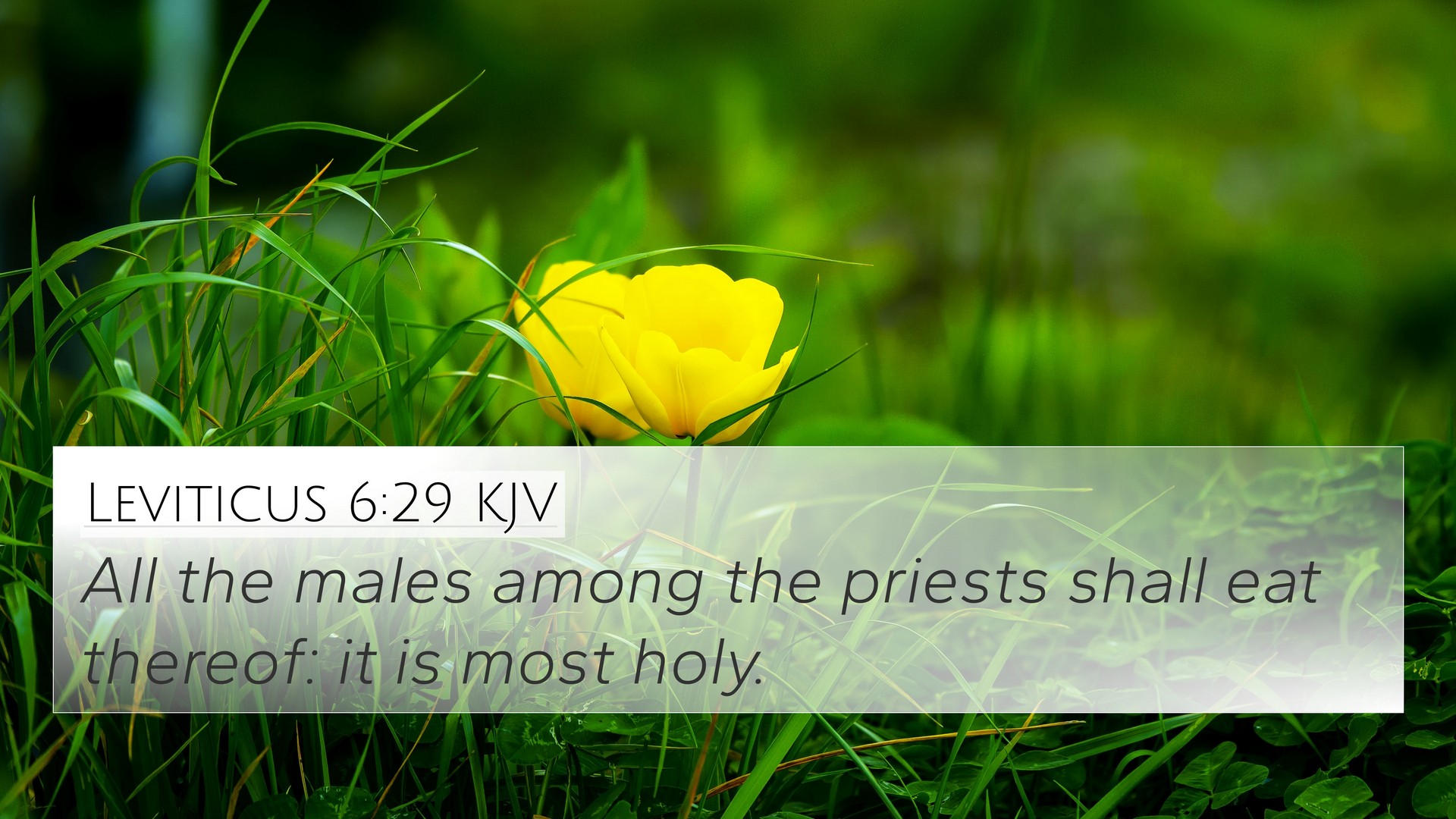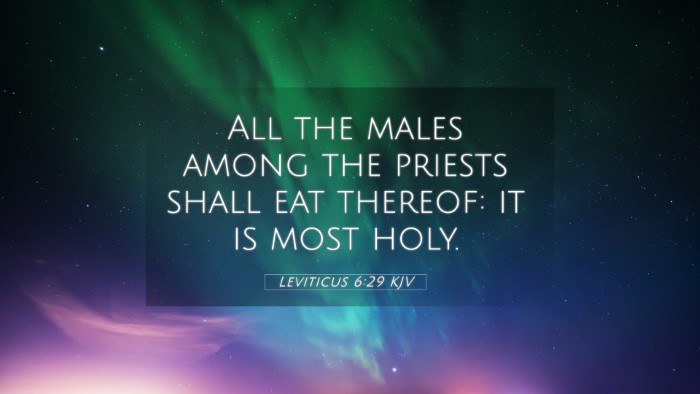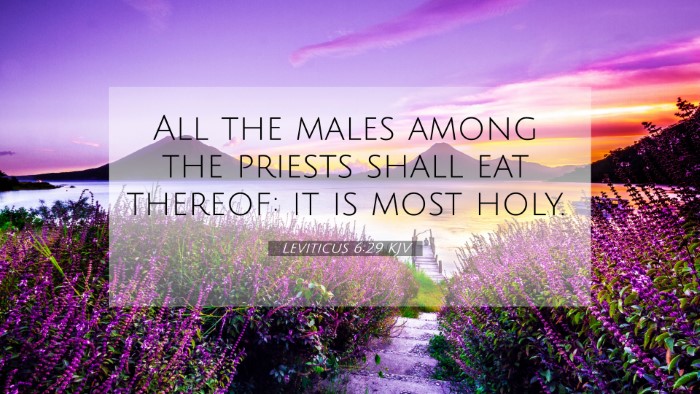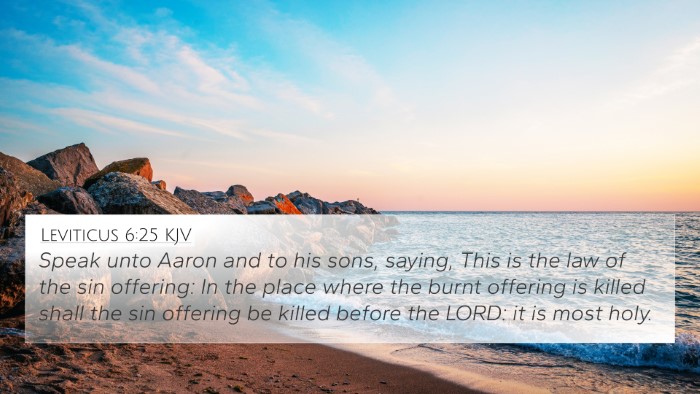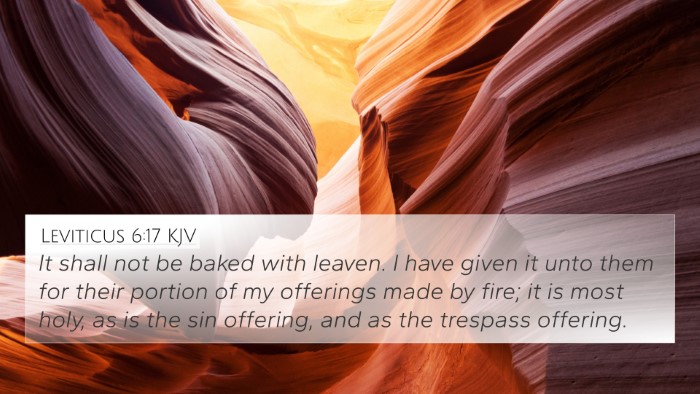Understanding Leviticus 6:29
Leviticus 6:29 states: "All the males among the priests may eat of it. It is most holy." This verse arises in the context of the instructions for the offerings of the Israelites, particularly concerning the sin offerings, which are meant to atone for the sins of the people.
Meaning and Context
The passage indicates a significant aspect of the priestly duties and privileges. Below are key insights derived from various public domain commentaries:
- Matthew Henry: He stresses that the "most holy" status of the offerings signifies their dedication to God. The priest's ability to eat these offerings emphasizes their unique role in mediating between God and the people.
- Albert Barnes: Barnes notes that eating of the offerings symbolizes communion with God. Only males among the priests partook in this privilege, representing their leading role in worship and sacrificial rites.
- Adam Clarke: Clarke elaborates on the holiness of the offerings, stating that they are a type that prefigures Christ. He insists on the importance of these instructions as they underscore the preservation of divine order and holiness in worship.
Cross-Referencing Biblical Texts
This verse interconnects with several other scripture references, providing deeper insights into the relational dynamics established through offerings and the priesthood. Below are pertinent cross-references:
- Exodus 29:33: Discusses the priests eating the offerings as a means of sharing in the holiness of the sacrifices.
- Leviticus 10:12-13: Provides instructions regarding the consumption of the offerings by the priests, emphasizing their responsibilities.
- Numbers 18:9: Reinforces the idea that most holy things belong to the priests, making it clear that these offerings are part of their sustenance.
- 1 Peter 2:9: Alludes to believers as a royal priesthood, drawing a parallel between Old Testament practices and New Testament identity.
- Hebrews 7:27: Portrays Jesus as the ultimate sacrifice, highlighting the transition from the old covenant to the new covenant.
- Psalm 104:14: References God providing food for His priests, symbolizing ongoing provision and care.
- Jeremiah 33:18: Mentions the continuity of priests serving in the temple, relating to their divine appointment and sustenance.
Thematic Connections
The themes embedded in Leviticus 6:29 extend significantly. Here are some of the connections that can be derived:
- Divine Holiness: The offerings are declared "most holy," which connects with various references that emphasize God's holiness and the need for purification.
- Priestly Duties: The obligations and privileges of the priests are put into context through cross-referencing, illustrating their unique role in spiritual mediation.
- Communion with God: The concept of partaking in the offerings as communion reflects the broader themes of intimacy between the divine and humanity.
- Sacrificial System: The sacrificial system laid down in the Old Testament points to the need for atonement, which finds its fulfillment in Christ in the New Testament.
Tools for Bible Cross-Referencing
For further exploration of the Bible verse connections, various tools can assist in studying the intricacies of scripture. Here are some recommended methods:
- Bible Concordance: Utilize a concordance to locate related verses and themes across both testaments.
- Bible Cross-Reference Guide: A guide will help identify relevant verses, enhancing understanding and study depth.
- Cross-Referencing Bible Study: Engaging in a systematic study using tools designed for Bible cross-referencing can unveil significant interconnections.
User Intent Keywords
When searching for connections around Leviticus 6:29, consider these questions:
- What verses are related to Leviticus 6:29?
- Find cross-references for Leviticus 6:29.
- How do Leviticus 6:29 and Ex 29:33 connect?
- Similarities between Leviticus 6:29 and Hebrews 7:27.
Conclusion
The examination of Leviticus 6:29 provides insight into the nature of holiness, the priesthood, and the themes of sacrifice that are crucial for understanding the broader narrative of the Bible. By utilizing cross-references and thematic study, deeper truths about the connections between the Old and New Testament can be uncovered, enriching one's biblical knowledge.
